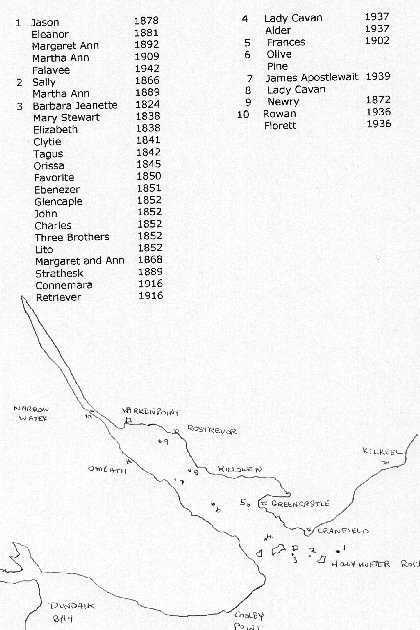We all recall from our school days, tales of cruel shore people luring ships’ captains unto rocks with bright lights. They were after the spoils of wrecks, and they cared not at all for the watery fate of sailors
It might be argued, from the poor design of coastal boats, the unseemly alacrity with which ships and crews were replaced (the new ships often named after the lost vessels), and the insistence that captains sail whatever the weather, that most ships’ owners were almost as heartless. The accompanying map and its plethora of wrecks tell their own story. Nor are these lists comprehensive!
A granite lighthouse was built at Cranfield in 1803 in an attempt to reduce the attrition rate of sailors. In 1823 it was replaced by the Haulbowline Lighthouse that still today stands on that mid-channel island. Yet just a year later the sloop ‘Barbara and Janette’ was lost after it struck the Bar and sank.
In 1830 another lighthouse was built at Greenore but casualties continued. In 1838 the Mary Stewart went down, as did the Elizabeth. The Clytie sank in 1841, the Tagus in 1842, Daisy of Beaumaris in 1844 and Orissa in 1845. Local dignitaries, M.Ps and businessmen without success, petitioned the government for channel improvements .
In 1850 the schooner Favourite was lost on the Bar and the following year it was the turn of the coaster Ebenezer from Preston, going down with the loss of three lives. The following January the brigantine Glencaple of Dumfies was lost but her crew saved. But severe storms of the time resulted in the loss of the John And Charles, the Lito and the Carnarvon smack Three Brothers, with her crew also perishing.
Not until the late 1860s was work undertaken to dredge and widen the channel, the object being to create a wide and deep passageway (600 feet by 21 feet deep). On completion it was no more than 18 feet deep and marked with keel buoys. Two leading lighthouses at Narrow Water indicated from several miles out the line of the bar channel. They still do.
After that, ships carrying our exports and imports were a little safer but some ships, in contradiction of the dictum ‘any port in a storm’, preferred to stay outside the Lough because, despite the improvements the entrance was still narrow and hazardous in bad weather.
In 1866 the Sally with her captain Henry Coffey and a crew of six were lost off Cranfield. The schooner Margaret and Ann was lost with a number of her crew in 1868. In 1872 the smack Newry went ashore near Warrenpoint. In 1873 the Preston Schooner Margaret Ann sank with the loss of three crew members. In 1881 the Eleanor from Holyhead to Greenore crashed on the Hollyhunter and was a total loss. In 1889 the schooner Martha Ann ran aground at Cranfield, and the steamship Strathesk, bound from Newry to Glasgow, ran on the rocks at Haulbowline Lighthouse. Three years later the iron dandy-rigged craft Margaret Anne of Lancashire was lost on the Bar. In 1902 the Frances, a smack of Carnarvon became a loss off Greenore. The Martha Ann, a schooner from Newry bound for Liverpool with granite from Annalong went down in 1909.
The greatest loss ever was from the Connemara and Retriever in 1916, a story already told in these pages.
There was relative peace until the 1930s. The Pine and the Olive were both steamers of Fishers from Newry when they collided inside the Lough in 1936. Fishers’ Rowan also collided at Narrow Water with the Florett in the same year. In 1937 the Lady Cavan rammed into the Alder which had anchored a short time earlier off the Greencastle coast during dense fog. The captain, his wife and four crew members perished. There is a comprehensive and excellent article, written by Leslie Campbell on the sinking of the Alder, to be found at http://freepages.genealogy.rootsweb.ancestry.com/~rosdavies/WORDS/AlderSinking.htm
There have been few incidents of the loss of commercial shipping since, though our earlier article, ‘Dangerous Waters’ , indicated that Carlingford Lough and its vicinity remain dangerous waters for sailors of all kinds.
… more Newry Shipping Losses ? …
